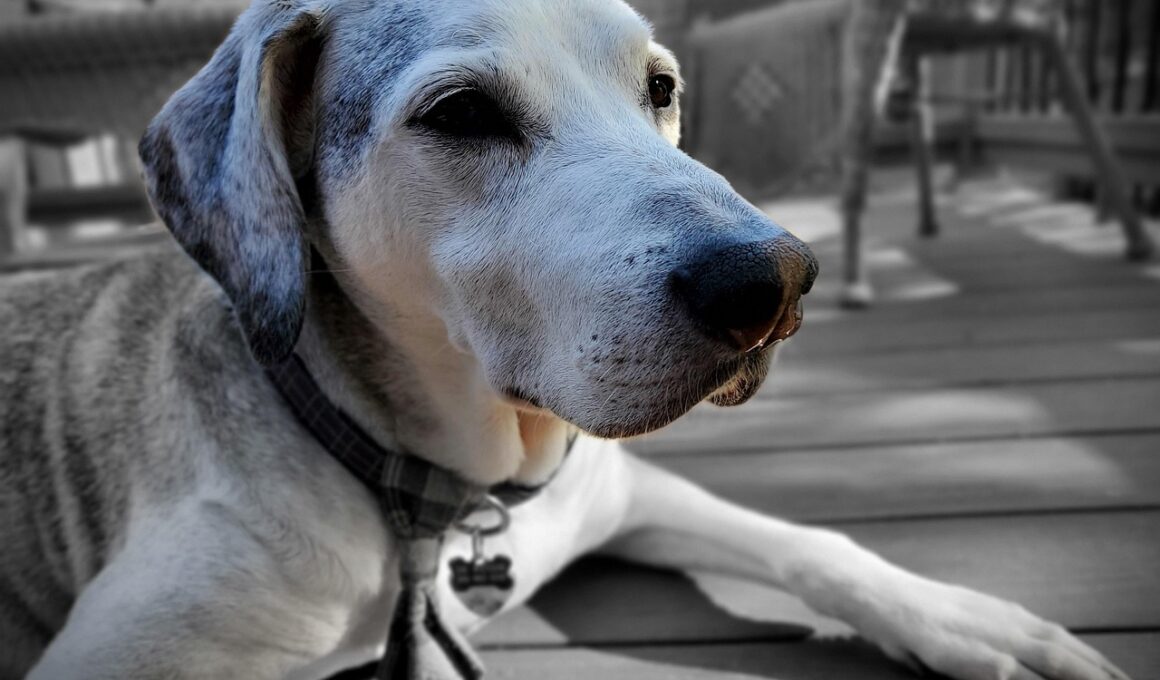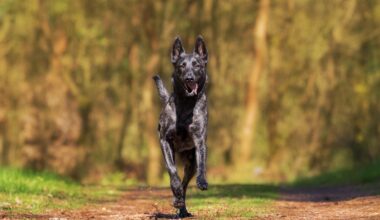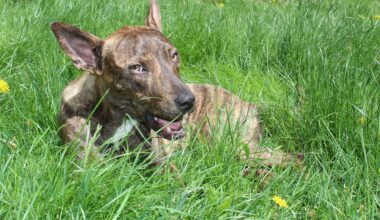Grooming Senior Dogs: Tips for Maintaining Health and Comfort
Grooming is vital for the health and comfort of senior dogs. As dogs age, their grooming needs change, and it’s essential to adapt your grooming routine. Senior dogs typically require more frequent grooming sessions than younger ones. Regular grooming helps to reduce matting, which can be uncomfortable or painful for older dogs. Aside from maintaining a healthy coat, grooming provides an excellent opportunity to check for any skin irritations or lumps. It is crucial to keep an eye on their nails, as senior dogs may not wear them down naturally. It’s advisable to schedule regular vet visits to address any underlying skin conditions that might arise. Additionally, using specialized grooming tools can help protect their sensitive skin. Remember to choose low-stress environments during grooming to prevent anxiety. The comfort of your elderly dog must come first during the grooming process. Gradually introduce your senior dog to a new grooming routine, allowing them time to adjust. Overall, effective grooming has significant benefits, keeping your senior dog healthy and comfortable throughout their golden years.
One of the first steps in grooming senior dogs is to ensure that their coat is clean. Bathing them every month helps to keep their coats fresh, especially if they have skin sensitivities. Using mild, dog-specific shampoos can prevent irritation. It’s always best to consult your veterinarian for suitable shampoo recommendations. After bathing, drying is essential. Older dogs may struggle with chill, so consider using a towel or a pet dryer set on low. Avoid taking them outside immediately after a bath to prevent them from getting cold. Additionally, be gentle while brushing your dog’s coat to avoid pulling on their sensitive skin. Use a soft brush suitable for your dog’s coat type. Pay special attention to their ears, as they can accumulate dirt and wax. Cleaning their ears with vet-recommended solutions helps to prevent infections. Furthermore, remember to clean their teeth regularly to ensure good oral health. Dental disease is common in senior dogs, and regular brushing or dental chews can help manage this. Overall, maintaining cleanliness is an integral part of grooming that supports your senior dog’s health and comfort.
Handling Sensitive Skin During Grooming
Senior dogs often experience changes in their skin, becoming drier and more sensitive. This shift requires special attention during grooming sessions. Choosing the right products is vital. Look for hypoallergenic or moisturizing shampoos specifically formulated for older dogs. Avoid harsh chemical products that can exacerbate skin issues. It can also be beneficial to test any new products on a small area first before using it over their entire body. Additionally, while grooming, ensure that your brush has soft bristles to avoid causing any scratches or irritation on their skin. Brushing should be done gently to help avoid any discomfort. If your senior dog has any noticeable skin conditions, it is essential to consult your veterinarian before proceeding with any grooming. Proper hydration plays a critical role in maintaining healthy skin, so ensure that your dog has access to fresh water at all times. Incorporating a balanced diet rich in fatty acids can also significantly improve skin health. Therefore, paying attention to skin changes can ensure that their grooming experience is comfortable and beneficial to their overall well-being.
Nail trimming is another essential aspect of grooming senior dogs that cannot be overlooked. As dogs age, their activity levels decrease, which means that their nails may not wear down naturally. Regularly checking and trimming their nails can prevent discomfort as overgrown nails can cause pain or lead to mobility issues. You may want to use specialized nail clippers or a grinder, depending on your dog’s comfort level. Additionally, the use of treats during nail trimming sessions can encourage a positive experience. If your senior dog is anxious about this process, try introducing it by just touching their paws initially. Gradually work up to trimming, allowing them to become accustomed to the process. If you’re uncomfortable doing it yourself, consider taking them to a professional groomer. Regularly trimming nails contributes significantly to your senior dog’s mobility and overall comfort. Pay attention to their behavior during these sessions; changes might signal that they are experiencing pain or discomfort. Establishing a routine for nail care will help maintain your dog’s overall health and comfort as they age, ensuring a happier life.
The Importance of Ear Care
Ear care is an essential component of grooming senior dogs, as they can develop ear infections or wax buildup. Older dogs may not groom themselves as effectively as they did when younger, making regular ear cleaning necessary. Use a cotton ball or soft cloth with a vet-approved ear cleaner for gentle cleaning. Avoid using cotton swabs as they can push debris further into the ear canal. Inspect their ears regularly for any unusual odors, redness, or discharge. If any of these symptoms are present, consult your veterinarian immediately, as they may indicate an infection. Sometimes, regular ear cleaning can prevent infections from occurring in the first place. Monitoring your dog’s ears is vital for their overall health and comfort, as issues can result in pain and discomfort. Consider including ear cleaning as part of your regular grooming routine. Furthermore, rewarding your dog with praise or a treat can make ear cleaning sessions more positive. Regular ear care can enhance not only their health but also their overall well-being, contributing to comfortable and vibrant golden years.
Another critical aspect of grooming senior dogs is dental hygiene, as poor oral health can lead to various health issues. Seniors are particularly susceptible to dental diseases, making daily dental care essential. Incorporating regular tooth brushing using dog-specific toothpaste can help maintain their oral health. If your dog is not used to having their teeth cleaned, start slowly, allowing them to adjust to the process. You may also consider dental treats or toys designed to improve oral hygiene. These products can help minimize plaque buildup. Be proactive about scheduling dental cleanings with your veterinarian, as they can identify concerns before they advance. Regular check-ups are vital for overall health maintenance. Additionally, keeping your dog’s teeth clean can also help with bad breath and enhance their overall quality of life. It’s important to remember that each dog is different, and it may take time to establish a routine that works. In the long term, ensuring their dental health can significantly contribute to their comfort and happiness as they continue to age gracefully.
Creating a Comfortable Environment for Grooming
A comfortable environment during grooming sessions is essential for your senior dog’s well-being. Older dogs may be more sensitive and require a calm atmosphere. Consider grooming in a quiet area away from loud noises that might stress your dog. A non-slip surface is also crucial, as senior dogs may struggle with balance. You can use grooming tables specifically designed for pet grooming or even a flat surface with a non-slip mat. The right temperature is also essential, as elderly dogs can be sensitive to extremes in heat or cold. Ensure that the grooming area is well-ventilated but not too chilly. Use blankets, cushions, or towels to provide extra support and comfort. During grooming, take frequent breaks to allow your dog to relax and feel secure. Establishing a positive routine together can enhance their comfort during these sessions. This approach minimizes stress and allows them to enjoy the grooming process. Ultimately, a pet-friendly environment fosters a positive grooming experience for your senior dog, leading to better grooming outcomes and a more delightful bond between you.
Ensuring mental stimulation is another important component when grooming senior dogs. While the grooming process can be seen as a mundane task, incorporating engaging activities can stimulate their minds. Use interactive toys or treats that entice your dog during breaks in grooming. Making this a playful process can help alleviate anxiety and create a more enjoyable experience for both of you. Additionally, you can play soothing music or even talk to your dog to ease any nervousness during grooming. Regular engagement during grooming sessions can foster a stronger bond and positively influence the grooming relationship. It also helps develop trust, making future grooming sessions easier for both the dog and owner. Consistency in these routines goes a long way, as senior dogs thrive on reliability. Moreover, recognizing their unique personalities and preferences can tailor the grooming experience according to their needs. Adapt and be flexible, as every dog is different; some may prefer a gentler touch, while others thrive on more assertive grooming techniques. Mental stimulation remains a key avenue to ensure a joyful and enriching experience for your senior dog, especially during grooming routines.


